#gaja simha
Photo




Bhoga Nandeeshwara Temple
Nandi Hills, Chikkaballapur, Karnataka, India.
Panduranga Sharma B wrote :
Arunachaleshwara 🔱
The Arunachaleshwara temple is said to represent the childhood phase of Shiva. The temple is said to be built by the Ganga dynasy when the Nolamba dynasty was overrun by the Ganga king Marasimha in 974 AD.
The temple houses a Linga carved out of black stone.
Gaja Lakshmi adorns the lintel of the entrance while dancers and musicians are carved on both the sides of the main door.
Outside the sanctum of Arunachaleshwara there is a unique murthi of Lord Ganesha called Simha Ganapathi or Ugra Ganapathi. In front of this temple is a Nandi made of granite inside a separate mantapa.
On the south side in the Pradakshina Patha, just behind the Vimana is the Apita Kuchamba sanctum, the consort of Arunachaleshwara. On all sides surrounding the garbhagudi are carvings of Shiva-Parvathi kalyana and the Saptharishis.
(via Instagram: Panduranga Sharma B)
55 notes
·
View notes
Text
Celebrating Lord Venkateshwara’s Grand Festival-Srivari Brahmotsavam 2020
Srivari Brahmotsavasam is celebrated in the month of September and October every year, praising the fame of Lord Venkateshwara, and Goddess Padmavathi on the eve of Dussehra festival. Do you know that Lord Venkateshwara is the only God who enjoys more than 450 festivals celebrated in a year? Among all festivals, Brahmotsavams are the most popular ones.
Significance and history behind Tirumala Brahmotsavams
Brahmotsavam by the name has Brahma, the creator, and Utsavam means celebration, i.e., celebrations initiated by the creator Brahma for Lord Venkateshwara. History says that Brahma comes to earth to conduct the festival for Lord Venkateshwara by chanting Sri Venkateshwara Sahasranama Stotra. The festival was signified by a small, empty wooden chariot called Brahmarathnam, which moves ahead of the processions of Lord Venkateshwara.
What to know about Tirumala Brahmotsavams 2020?
It is a 9-day festival celebration of Lord Venkateshwara, which starts on the 19th of September, 2020, that falls on Saturday.
The first day (19-09-2020)
The morning begins with Dwajarohana, raising the Garuda Flag, which signifies the beginning of the festival. The same day night, we can see Lord Venkateshwara taking processions on a large seven-headed Adisesha Vahana.
The second day (20-09-2020)
In the morning, Swami appears on a small five-headed Adisesha Vahana and takes processions. Similarly, in the night, it is Hamsa Vahana in which you can see Lord Venkateshwara sitting on Hamsa, the swan, and taking processions.
The third day (21-09-2020)
The third morning begins with the Lord Venkateshwara appearing as gigantic and courageous in Simha Vahana, the Lion, and takes processions. The day ends with the Swami appearing on Muthyapu Pandiri Vahana, decorated with colorful and fragrant flowers.
The fourth day (22-09-2020)
The morning starts with the Swami taking processions in the amazing Kalpa Vriksha Vahana. Kalpa Vriksham is a tree that is believed to give unlimited money. You should definitely have more than two eyes to see the shine of both Vahana and Swami. Now at the end of the day, we can see the Lord in Sarva Bhoopala Vahana. In this Vahana, the chariot appears like the decoration inside the Garbagudi of the main idol.
The fifth day (23-09-2020)
Now we move to the fifth day morning to see Swami in Mohini Avataram. Mohini is the Hindu Goddess and the only female avatar of Lord Vishnu. Therefore, Lord Venkateshwara takes processions in this avatar for devotees. The same day ends with the Swami taking processions in Garuda Vahana, which has a giant Garudas carrying Swami in front of the chariot.
The sixth day (24-09-2020)
On the sixth day morning, it is Hanumantha Vahana, Swarna Ratha. On this day, Swami takes processions in Anjaneya swami Vahana on a Golden chariot, and in the night time, he takes caravans in Gaja (Elephant) Vahana in front.
The seventh day (25-09-2020)
Here comes the seventh day morning where you can see Utsava Swami in Surya Prabha Vahana. This Vahana resembles the shape of the Sun in the front, and the sun rays are decorated with long clothes at the back. Since in the day he was traveling on the Sun, in the night, he takes processions in Chandra Prabha Vahana, i.e., the Moon.
The eighth day (26-09-2020)
On the eighth day morning, we have Rathotsavam. This day is celebrated grandly since Lord Venkateshwara sits on top of the gigantic chariot. Devotees pull the chariot with all their strength and devotion for taking God to processions. The same day night, Swami takes caravans in Aswa (horse) Vahanam, which looks delightful.
The ninth day (27-09-2020)
On the final day of Brahmotsavams, we can see Lord Venkateshwara in Pallaki Utsavam; Swami goes for processions in a wooden chariot decorated with all flowers like how a king/queen takes processions to temples or any place in their country. The Brahmotsavams for Swami ends with Chakrasnanam (Dwajarohanam), the same day night. Swami is taken to Pushkarani, the temple pond, for a bath and returns to the temple in his original condition how he was, before carrying him out for processions.
Conclusion
This is how Brahmotsavams happen in Tirumala every year, which also has Dussehra Brahmotsavams in parallel for Goddess Padamvathi. Hope this blog was informative and useful to you. Keep reading our blogs for more info about Tirumala and its fame.
Read More...
Contact us :
Email us : [email protected]
Website : http://tirupati-balaji.com
1 note
·
View note
Text

Kshethra Pala Bhairava:
[Guard of Earth Bhairava]
Raktha jwalaa Jada dharam, sasi dharan, Rakthanga thejo mayam,
Dakka Shoola kapala pasa gadha dharam Bhairavam,
Nirvanam Gathavahanam Trinayanamcha Ananda kolahalam,
Vande bhootha pisacha natha vadukam Kshethrasya palam Shubham. || 1 ||
I salute the leader of ghosts and Ghouls, Lord Bhairava,
Who wears the red flame as his matted hair,
Who wears the moon, who shines in red colour,
Who holds a drum, spear, skull, rope and mace in his hands,
Who is nude, who rides on a dog, who has three eyes,
Who is always happy and exuberant and is the guard of the temple.
[6/4, 10:56 AM] Babu.r..**: Kshethra Pala Bhairava:
[Guard of Earth Bhairava]
Raktha jwalaa Jada dharam, sasi dharan, Rakthanga thejo mayam,
Dakka Shoola kapala pasa gadha dharam Bhairavam,
Nirvanam Gathavahanam Trinayanamcha Ananda kolahalam,
Vande bhootha pisacha natha vadukam Kshethrasya palam Shubham. || 1 ||
I salute the leader of ghosts and Ghouls, Lord Bhairava,
Who wears the red flame as his matted hair,
Who wears the moon, who shines in red colour,
Who holds a drum, spear, skull, rope and mace in his hands,
Who is nude, who rides on a dog, who has three eyes,
Who is always happy and exuberant and is the guard of the temple.
[6/4, 10:56 AM] Babu.r..**: Asithanga Bhairava:
[Dark Bodied Bhairava]
Trinethram, varadam shantham, munda mala bhooshitham,
Swetha varnam, krupa murthim, Bhairavam Kundalojjwalam,
Gada kapala samyuktham, kumarsya digambaram,
Banam pathrancha sankham cha Aksha maalaam kundalam,
Naga Yagnopaveetham cha dharinam suvibhooshitham,
Brahmani shakthi sahitham, hamsaroodam suroopinam,
SArvabheeshta dharam nithyam asithangam Bhajamyaham. || 2 ||
I pray the dark Bhairava who fulfills all desires,
Who is forever, who has three eyes, who blesses and is peaceful,
Who wears a skull garland, who is white, who is the Lord of mercy,
Who shines in his ear globes, who holds mace and the skull,
Who is young and nude, who holds arrow, vessel, conch, bead chain and ear globes,
Who wears snake as sacred thread, who is well ornamented,
Who is with Goddess Brahmani, rides on a swan and is good to look at.
[6/4, 10:56 AM] Babu.r..**: Krodha Bhairava:
[Angry Bhairava]
Trinethram, varadam, santham, kumarancha digambaram,
Gadam shankam cha Chakrancha pada pathrancha dharinam,
Lakshmyacha sahitham vame garudasana susthitham,
Neela varnam maha devam Vande Sri Kroda Bhairavam. || 3 ||
I salute the angry Bhairava, who is blue and a great God,
Who has three eyes, blesses, peaceful, young and nude,
Who is armed with mace, conch, wheel, rope and a vessel,
Who is near Goddess Lakshmi riding on Garuda the eagle.
[6/4, 10:56 AM] Babu.r..**: Unmatha Bhairava:
[Frantic Bhairava]
Trinethram, varadam, santham, kumarancha digambaram,
Hema Varnam, maha devam, hastha vahana susthitham,
Gadgam, kapalam, musalam, dathantham, kedagam thadha,
Varahi shakthi sahitham Vande Unmatha Bhairavam. || 4 ||
I salute that Frantic Bhairava who is power called Varahi,
Who has three eyes, blesses, peaceful, young and nude,
Who is of golden colour, great God and rides on a swan,
And who holds sword, skull, Pestle and also the shield.
[6/4, 10:56 AM] Babu.r..**: Ruru Bhairava:
[Teacher Bhairava]
Trinethram, varadam, santham, kumarancha digambaram,
Dangam krisna mrugam pathram bibranam chakru panakam,
Maheswaryayudham devam vrusharoodam smitha vahanam,
Shudha sphatikam sankaram, namami Ruru Bhairavam. || 5 ||
I salute the Bhairava with the deer, who is like pure crystal and a destroyer,
Who has three eyes, blesses, peaceful, young and nude,
Who holds a hatchet, deer, drinking goblet and a sword in his hands,
Who has the armed Maheswari by his side and who is smiling and rides on a bull.
[6/4, 10:56 AM] Babu.r..**: Kapala Bhairava:
[Skull Bhairava]
Trinethram, varadam, santham, kumarancha digambaram,
Pasam, Vajram, thadha Gadgam pana pathranch dharinam,
Indrani shakthi sahitham Gaja vahana susthitham,
Kapala Bhairavam Vande padma ragha prabham Shubham. || 6 ||
I salute the Bhairava of the skull, who has a shining body,
Who has three eyes, blesses, peaceful, young and nude,
Who holds rope, Vajrayudha, Sword and Drinking Goblet,
Who has with him Indrani Shakthi, is being well praised and rides on an elephant.
[6/4, 10:56 AM] Babu.r..**: Chanda Bhairava:
[Fierce Bhairava]
Trinethram, varadam, santham, kumarancha digambaram,
Dhanur banancha bhibranam, Gadgam Pathram Thadaiva cha,
Koumari shakthi sahitham, Shikihi vahana sthitham,
Gowri varnayudham Devam Vande Sri Chanda Bhairavam. || 7 ||
I salute the Chanda Bhairava who is pure white in colour,
Who has three eyes, blesses, peaceful, young and nude,
Who holds rope, Vajrayudha, Sword and Drinking Goblet,
Who has with him Kaumari Shakthi and rides on a peacock.
[6/4, 10:56 AM] Babu.r..**: Bheeshana Bhairava:
[Terriffic Bhairava]
Trinethram, varadam, santham, kumarancha digambaram,
Gadgam soolam Kapalancha darinam musalam thadha,
Chamunda shakthi sahitham pretha vahana susthitham,
Raktha varnam maha devam Vabde Bheeshana Bhairavam. || 8 ||
I salute the Terriffic Bhairava who is a great God of blood red colour,
Who has three eyes, blesses, peaceful, young and nude,
Who holds sword, trident, skull and pestle in his hand,
Who has with him Chamunda Shakthi and rides on a corpse.
[6/4, 10:56 AM] Babu.r..**: Samhara Bhairavam:
[Annihilator Bhairava]
Dasa bhahum trinethram cha sarpa yagnopaveethinm,
Damishtra karala vadanam ashtaiswarya pradhayakam,
Digambaram kumarancha simha vahana samsthitham,
Soolam damarugam shankam, gadam chakrancha darinam,
Gadgam pathram cha Gadwangam pasa mangusa meva cha,
Ugra roopam madonmathamam bada vaalai,
Chandika shakthi sahitham dyayeth samhara Bhairavam. || 9 ||
I meditate on Bhairava the destroyer, who is with Chandika Shakthi,
Who has ten hands, three eyes and snake as sacred thread,
Who has protruding teeth, fearful look and grants eight type of wealth,
Who is nude, a youth and rides on a lion,
Who holds trident, drum, conch, mace and wheel in his hands,
Who holds sword, vessel, Gadwangam, rope and goad.
And who has fearful looks, wears skull garland and greatly exuberant.
1 note
·
View note
Link
Visit stepstogether.in for detailed posts
0 notes
Photo
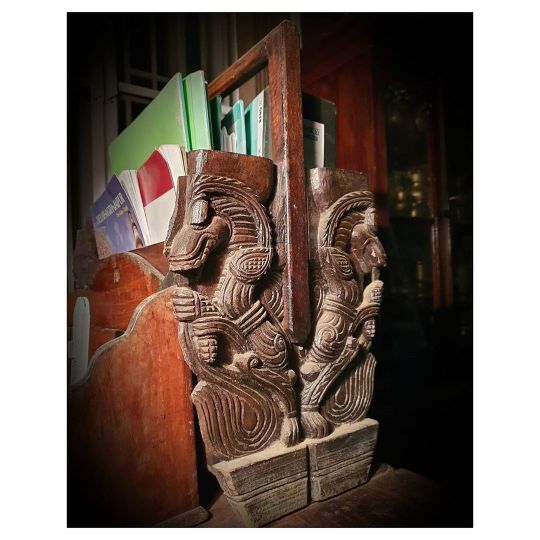
. . Know your Antiques - Today's feature The Mythical creature Yazhli or Vyala . . Yazhli or Vyala is a mythical creature believed to be the guardian angels of doors and entrances, they are almost found in all South Indian temples. Portrayed as Part Lion, Part Elephant and Part Horse, Some with birds features...It is auspicious and believed to ward of evil and evil eye from places they are present, Some claim these were real creatures which roamed the Earth 🌎 in those days and many say it was their super power which was used in building greatest temples in non mechanized world, . . Yazhlis are briefly classified according to their features 1. Simha yazhli - Lions features 2. Pakshi Yazhli - Bird features 3. Puravi Yazhli - Horse featured 4. Gaja Yazhli - Elephants features 5. Yaksha Yazhli- Divine angelic 6. Kurma Yazhli - turtle features 7. Macha Yazhli - Fish featured similar to the mermaid 8. Varaha Yazhli - Boar featured . . seen here is my Antique Rosewood File rack features Puravi Yazhli 4 nos two on either side, one of my favorite pieces @indiantiquest . . Not on Sale Heirloom . . Antiques: For Antique collectibles follow us @ . instagram.com/indiantiquest . m.facebook.com/pg/indiantiquest/ . in.pinterest.com/indiantiquest . indiantiquest.blogspot.in . indiantiquest.wordpress.com . indiantiquest.com . amazon.in/shop/indiantiquest . tumblr.com/blog/indiantiquest . g.page/indiantiquest . #indiantiquest #amazoninfluencer #antiqueshop #antique #antiquebrass #antiquecopper #bronze #antiques #vintage #vintagevignettes #kitchenvessels #vintageart #vintagedecor #indianantiques #curiocollection #interiorstyling #foodstylingprops #homedecor #foodphotoprops #antiquesforsale #decorativeantiques #kitchenprops #antiquesforsale #vintagehomedecor #vintagevessels #antiquedealersofinstagram #myantiquestory #brasscollectibles #antiquedecor #interiordecor https://www.instagram.com/p/CB0o7tmJYJu/?igshid=19yyas54vt8b0
#indiantiquest#amazoninfluencer#antiqueshop#antique#antiquebrass#antiquecopper#bronze#antiques#vintage#vintagevignettes#kitchenvessels#vintageart#vintagedecor#indianantiques#curiocollection#interiorstyling#foodstylingprops#homedecor#foodphotoprops#antiquesforsale#decorativeantiques#kitchenprops#vintagehomedecor#vintagevessels#antiquedealersofinstagram#myantiquestory#brasscollectibles#antiquedecor#interiordecor
0 notes
Text
Nature Vocabulary in Sanskrit

nature = प्रकृति [f] (prakrti)
earth = पृथ्वी [f] (prthvī)
ground / land = भूमि [f] (bhūmi)
stone = अश्मन् [m] (ashman)
water = जल [n] (jala), अप् [f] (ap)
river = नदी [f] (nadī)
lake = सरोवर [m] (sarasovar)
sea = समुद्र [m] (samudra)
sun = स्वर् [m] (svar), सूर्य* [m] (sūrya)
sky = द्यु [m] (dyū)
rain = वृष्टि [f] (vrshṭi)
snow = हिम [m] (hima) - whence Himalayas
cloud = मेघ [m] (megha)
season = ऋतु [m] (rtu)
Spring = वसन्त [m] (vasanta)
Summer = ग्रीष्म [m] (grīshma)
Monsoon = वर्षा [f] (vrshā)
Autumn = शरद् [f] (sharad)
Winter = हेमन्त [m] (hemanta)
cold season = शिशिर [m] (shishira)
fire = अग्नि [m] (agni), पावक* [m] (pāvaka)
tree = वृक्ष [m] (vrksha), तरु [m] (taru)
wood = द्रु [m] (drū)
leaf = पत्र [n] (patra)
flower = पुष्प [n] (pushpa), पुल्ल [n] (pulla)
fruit = फल [n] (phala)
forest = वन [n] (vana), अरण्य [n] (araṇya)
mountain = पर्वत [m] (parvata)
jungle, wasteland, desert = जङ्गल [m] (jangala)
animal = प्राणी [m] (prāṇī)
elephant = गज [m] (gaja), हस्तिन् [m] (hastin)
monkey = वानर [m] (vānara)
deer, antelope = मृग [m] (mrga)
tiger = व्याघ्र [m] (vyāghra)
lion = सिंह [m] (simha)
wolf = वृक [m] (vrka)
bird = वि [m] (vi)
eagle = गरुड [m] (garuḍa)
snake = सर्प [m] (sarpa)
*may also refer to deities
#sanskrit#dead language#sanskrit learning#sanskrit vocabulary#sanskrit language#language learning#vocabulary lists#langblr#studyblr#nature#nature vocabulary#south asian languages#ancient languages
374 notes
·
View notes
Text
The origin of monument building in Mahabalipuram is attributed to the mighty Pallava dynasty that ruled south India from around 3rd century CE with their capital at Kanchipuram, after the decline of their overlords, the Satavahanas. The early Pallavas were seafaring in nature, and they spread their culture in many parts of what is now known as the South East Asia. Many ancient inscriptions from these parts written in the Pallava-Grantha script clearly establish the early connections, while the early sculptures from these places also show a remarkable influence of the Pallavan style.
Pallava script
The greatest influence of the Pallavas was undoubtedly their script, the Pallava script. It was started in the 6th century, and belonged to the group of more popular form of Brahmi scripts. Along with their spicy mutton curry (another popular Pallavan gift to the SE Asian nations), their granth or script came along with their boats, and gave rise to different writing formats, which are now used in many parts of Southeast Asia. The four older scripts, which are directly derived from the Pallava granth are Mon, Khmer, Kawi, and Chams, with the Khmer Empire being first to take up the Pallavan script. The Angkor kings also started using the tittle Varman , like their Pallava counterparts in India. It is believed that the the modern Lao, Thai, and Khmer scripts are all derived from the script and writing system first adopted by the Khmer dynasty.
In the 7th century CE, the mighty Pallavas were defeated by the Chalukyans under Pulakesin II (609-642 CE), and they lost the Telugu districts. Mahendravarman I (600-30 CE) now controlled a much reduced kingdom that extended over Thanjavur, Chingleput, Arcot, Tiruchchirappalli, Ghittoor, and Salem. Despite his humiliating defeat, Mahendravarman I is well remembered in history as a great poet and musician, and more often as a pioneer of the South Indian style of temple painting and architecture. The Mandagapattu inscription of early 7th century (written in Laksitayana inscription) describes Mahendravarman I as a curious learner, who created a temple “dedicated to Brahma, Visnu, and Siva, to be made without the use of brick, wood, metal, or mortar.”

The monuments in Mahabalipuram (placed between 6-8th c. CE), show a beautiful amalgamation of religion and culture, through depiction of various stories from the Hindu epics. These are expressed as reliefs and sculptures on rock, often on a gargantuan scale, that effortlessly integrates sculptural works with nature. The place has forty monuments, that can be divided into five groups, based on their construction types:
1. Monoliths or Rathas: these are free-standing structures (mostly temples) cut out of
solid rock, designed to look like the local ceremonial rathas or chariots;
2. Rock cut caves or Mandapas: these include pillared mandapas or halls excavated in rocks on hill-sides
3. Structural temples: the term refers to built-up masonry-temples, such as the Shore temple
4. Rock reliefs: reliefs on side walls of cave temples, sculpted on massive granite rocks on hill-edges; the majority of these are from the time of Narasirmhavarman I.
5. Various ASI excavated sites
According to M.S. Ramaswamy (1989), Mahabalipuram has ten major monoliths or rathas, ten rock cut caves, two rock reliefs, and three structural temples. It is interesting to note that the sculptures, reliefs, and architecture of the Pallavas incorporate aspects of Shaivism, Vaishnavism, and Shaktism all in one frame. This is significant, as it helps in understanding that the monuments were built prior to 9th c. CE (before the sectarian split between Vaishnavites and Shaivites occurred), when Hindus still followed the Upanishads, where they could worship god in all forms and aspects, without giving exclusive importance to any particular one (Boner, 1990). The five main deities that we find repeatedly in Pallavan era monuments are Shiva, Vishnu, Ganesha, Durga (Shakti), and Surya, and those that still worship these five without following the sectarian divide are known as Smarttas (Boner, 1990).
The Pancha Rathas or the Five Monoliths
This group of five monolithic structures are cut out from solid rock to create
North View of the 5 Pagodas about one mile south of Mahabilipoorum showing also a Lion and Elephant, the latter as large as life, the former larger, the whole cut sculptured from solid Granite stones – from a Sketch by Mr J. Braddock. J. Gantz’, 1825 (photo courtesy – British Library)
five free-standing temples (the term rathas commonly used for the monoliths is a misnomer, as none of the structures look like ceremonial rathas or temple chariots). The naming of the temples after the Pandavas and Draupadi is also purely symbolic, and has no historical basis or connections with the Mahabharata. It is believed that these monuments were created during the rule of Narasimhavarman I (630-668 CE), and are among the earliest structures of their type in India. It is interesting to note that the different forms of super-structures created here show artistic experimentation with various types of future temple roofing. The stones used for these monolithic temples are naturally available blocks of granite and diorite, and are dedicated to the forms and ideas of Shaivism, Vaishnavism, and Shakti. All the five monoliths are built on moulded plinths, they completely lack any ganas, sculptures are seen within tall niches, there are overhanging eaves with sometimes human faces seen on them, while the important sculptures are seen with makaras on brackets.

The layout of the Pancha Rathas (from Iconographic reflections on the Arjuna Ratha by Susan Huntington)

These monolithic ‘rathas’ could be experimental models created by the artisans before they actually started implementing these designs and building structural temples. So, here we are possibly looking at an ancient laboratory, where artists experimented with the transition of rock cut temples to structural ones.

Draupadi ratha: this is the smallest and the most elegant among the five rathas in this complex. it resembles a village mud hut with a thatched (curved) bangla chala or Bengal roof. There are four supporting pilasters in the corners, and three niches on three walls that are crowned by makara-toranas. The side facing west has the doorway, with two niches on two sides of the door containing dwarapalikas. The remaining niches show a standing Durga, and the east niche shows Durga standing on the severed head of the mahisasura (buffalo demon). Inside the sanctum, on the wall there is a four-armed standing Durga.
Durga or Kotravai seen with two male devotees (Kabalika sect)
kneeling at her feet. One of them has a sword in hand ready to
to cut his head off (sacrificial scene, common in Pallava sculptures), as an offering to the devi. There are four ganas watching from overhead. In front of this ratha stands a huge monolithic lion.
Devi’s dwarapalika
Devi’s dwarapalika
Durga, or Vishnu Ammai, as she is better known in Tamil Nadu, on Draupadi ratha wall
Arjuna ratha: Standing on the same plinth as the Draupadi ratha is the Arjuna ratha. Similar in design to the Dharmaraja ratha, though smaller, it is a square structure with steps leading to a shallow pillared mandapa in front. The ratha shows a two tiered superstructure and a hexagonal vimana. While the sanctum is now empty, the four walls are amply sculpted with carved panels between pilasters on four sides. There are five panels on three sides of the main cell with the central one holding prominent figures. The corner-panels show dwarapalas (quite debatable owing to their costumes, postures, and head-gears). One of the central panels (south facing) holds Shiva casually leaning on his Nandi, while the north facing wall holds a young looking Vishnu with his garuda, and Indra on his Airavata stands on the east facing wall. Directly in front of this temple stands a huge monolithic elephant.
Owing to the Indra panel and the elephant in front, the general belief among historians is that the temple was dedicated to Indra. However, according to Susan Huntington, the temple was more likely to have been dedicated to Aiyappan or Aiyyanar-Sasta, the son of Shiva and Mohini. The two women in the left side panel of Aiyyanar-Sasta riding his elephant are his two wives, Puranai and Putkalai. On the right panel we see an older man leading a child, which according to Huntington, are Aiyyanar-Sasta’s son Satyaka and his chief attendant Damanaka.
Vishnu with Garuda on north facing wall
The panels on two sides side of Vishnu and Shiva show a pair of mithuna couples, and two free standing males (whether they are dwarapalas is debatable) in the corner panels. Mithuna couples are also seen in the upper storey kudu panels. There are alternating simhas (lions) and gajas (elephants) carved at the base of this ratha. The decorative patterns used here are kudus and pavilions, similar to that of the Dharmaraja-ratha.
The monolithic bull sitting behind the Draupadi-Arjuna rathas
The group of figures on the east facing wall of the Arjuna’s ratha, which Susan Huntington says is that of Ayyappan or Aiyyanar-Sasta and not that of Indra.
Shiva with nandi

Bhima ratha : it is the largest among the rathas here, with
a vaulted barrel/wagon like roof. It is elongated in shape, and stands on a rectangular platform with four pillars and two pilasters on both the east and west sides. The ornamentation seen here are pavilions and false kudus on the upper storey, like the Dharmaraja ratha. The curved roof of this monolith and that of the Draupadi-ratha
reminds one of the village thatched huts. There are no figures carved on the walls of this ratha. From its elongated shape it has been derived that the temple was likely to have been a dedication to Anantasayi Vishnu.

East facing side of Bhima ratha

West facing side of Bhima ratha

Dharmaraja ratha (east facing side).
The highest temple situated at the southern end of this group is the Dharmaraja ratha. It is pyramidal in shape with a square platform. There are number of diminishing storeys on the upper part, with each storey showing pavilion rows above kudu/chaitya rows. The four corner blocks, have panels that have sculpted figures in them, and between the corner blocks are shallow mandapas with two pillars and two pilasters with simha bases. The eight sculptures on the corner blocks, show Brahma, Harihara, Skanda, one is the royal portraiture of king Narsimhavarma I (identified by the grantha inscribed epithets of the king), three others hold four-armed Shiva, and the last one is a beautiful image of Ardhanarisvara, combining Shiva (purusha) and Parvati (prakriti). The figures in the niches of the central tier are those that would eventually become popular in later temple iconography, such as the four-armed Natesa dancing on Apasmara, Gangadhara Shiva, Vishnu on Garuda, Vinadhara Dakshinamurti, Andhakaasuravadha, Shiva with Arjuna (it could also be Chandesvara or Bharata/nandi), Kankalamurti, Surya wearing karanda mukuta, Krishna on kaliya, Natya Dakshinamurti, along with women figures, devotees, and dwarapalas. There is also a depiction of Somaskanda Shiva on the west facing tier. The pranalas on roof are seen all around the ratha, with human and monkey faces as outlets.

Dharmaraja ratha (south facing side).

Nakula-Sahadeva Ratha: All the temples have a west entrance except the Nakula-Sahadeva Ratha, which has a south entrance. It is apsidal in shape, showing the same ornamentation as in the Arjuna and Dharmaraja rathas. There is a shallow porch in front with two simha based pillars. No carvings of figures are seen on this temple.
Besides the temple, stands the huge monolithic elephant, which according to some scholars, is suggestive of the elephant-back shape of the temple.

Krishna Mandapa
This rock cut cave depicts a scene of Krishna lifting the Govardhana hill, known as Goverdhana Uddhara. Here we see Krishna lifting Govardhana with his left palm, in order to protect the cowherds and and their families from the storm created by Indra, while his right hand shows the varada mudra. Near him are the gopis, looking at him in wonder. To his right is his brother Balarama, who is standing with his left hand on the shoulder of a gopa, and right hand on hip. Farther right we see a very natural representation of a cowherd milking his cow, while the cow licks its calf. Another gopi stands near holding milk-pots kept on a rope-sling, while carrying a bundle on her head; and a wood-cutter stands by her with his axe on his shoulder. We also see figures of a mother holding her child, and a cowherd playing his flute, while all around there are cows. The Goverdhana mountain is shown as full of lions, sphinxes, and griffins, at the left side, while an alert bull sits at the other end.



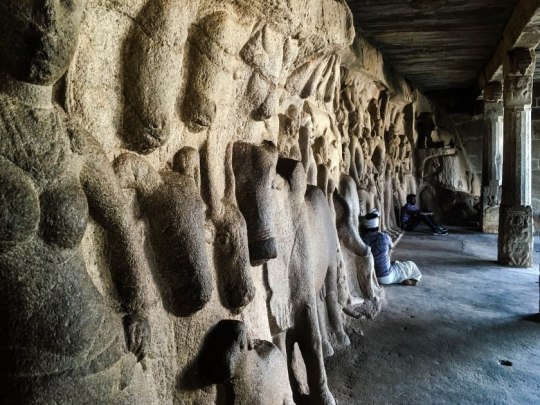


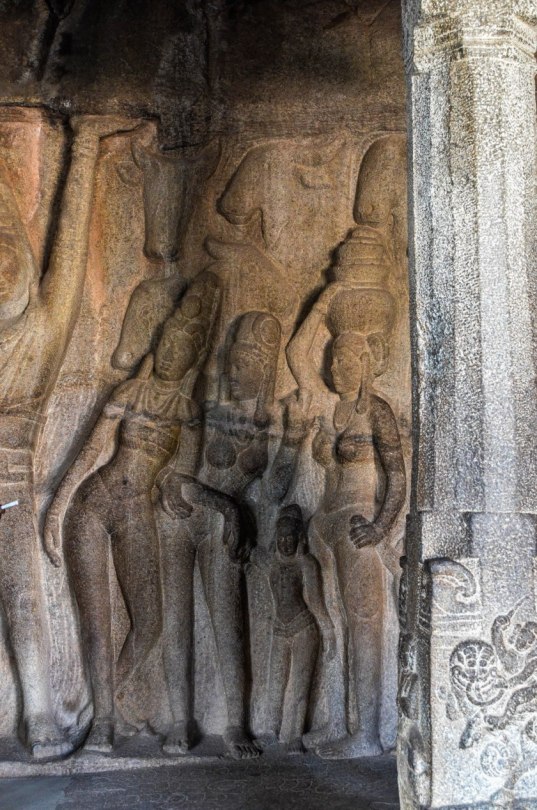



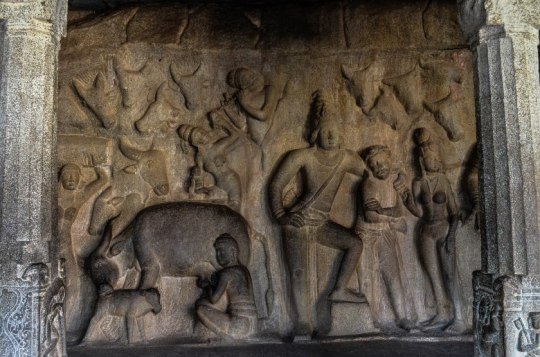
Few other Rock Cut Caves and the Butter Ball

Draupadi’s bath: a small kund holding water in the Mahabalipuram main hill top. (Photo courtesy : Zehra)
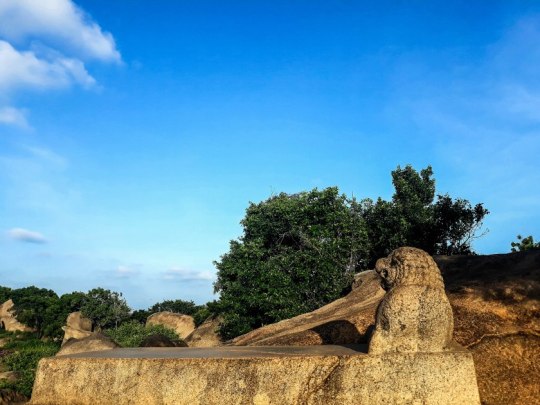
The Dharmaraja rock cut throne. It is a monolithic structure has a large rectangular seat and a lion sitting at one end. This area is believed to have been the main palace site. Seen at Mahabalipuram main hill top. (Photo courtesy : Zehra)

Gopi’s churn. On its rim is seen written ‘Sri-Kadhiti’ in
Pallava granth (Photo courtesy : Zehra)
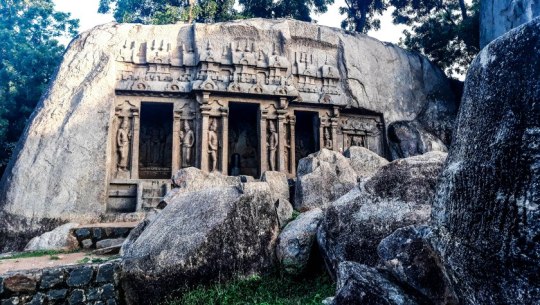
Triple celled rock cut shine of the 7th-8th century (Photo courtesy : Zehra)

Triple celled rock cut shrine of the 7th-8th century. The three cells are dedicated to Shiva (middle cell), Brahma, and Vishnu. Here unusually, Brahma is shown with a single face, wearing a cross mala of rudraksha beads. On his upper hands he holds a kamundala and a japmala, while the lower hands denote abhaya and katyavalambita (also seen in the other two deities). Shiva is shown with an axe and japmala, while Vishnu with his sankha and chakra. The word malla is seen inscribed (script style is of Narasimhhavarman’s
period) in Brahma’s cell, which fixes the date of these shrines. Dwarapalas are seen on the entrance niches, while a northern most separate niche holds an eight armed Durga. (Photo courtesy : Zehra)

A beautiful rock cut panel depicting elephants, monkey, and peacock. (Photo courtesy : Zehra)

Ganesha ratha: a three-storeyed structure with a similar roof as that of the Bhima ratha, but of better workmanship. The gable ends of the roof show a
human head wearing a trident like head dress. Kudus and pavilions are also present here. The roof shows elaborate designs, and with its nine vase like finials is the precursor of later period south Indian temple gopurams. A row of pilasters decorates
the sides and back of the Ganesha ratha, while the temple entrance is on the west.
Here we see the dwarapalas in corner niches, along with four lion-pillars and pilasters.

Varaha cave II on the main Mamallapuram hill. Near the Ganesha-ratha and behind Arjuna’s penance is the beautiful Varaha-mandapa. The shallow mandapa at front has four lion pillars and pilasters. The centre garbhagriha behind the pillared mandapa is empty with two dwarapalas guarding the cell. On the sides of sanctum are four wall panels that beautifully depict Gajalakshni, Durga, Varaha raising the bhu-devi from the ocean, and Trivikrama.

The Varaha panel: an unusual depiction of the Varaha avtaar rescuing bhu-devi. Here he is seen looking right and lovingly holding bhu-devi, instead of the typical depiction where he looks left and bhu-devi dangles from his tusk. Among those around him are Surya, Chandra, Brahma, and rishis. The right foot of Varaha is seen resting on Sesha naga. The depiction of lotus flowers and leaves and ripples suggest the presence of water below.

The Gaja-Lakshmi panel: here Lakshmi is seen sitting on a lotus wearing a crown typical of Pallavan sculpture, and a cross garland known as suvarnavaikakshaka, while her hands are suggestive of holding lotuses. The lotus leaves suggest water below.
The goddess is surrounded by her female attendants who are carrying water filled pots, while the two elephants are pouring water on her head.
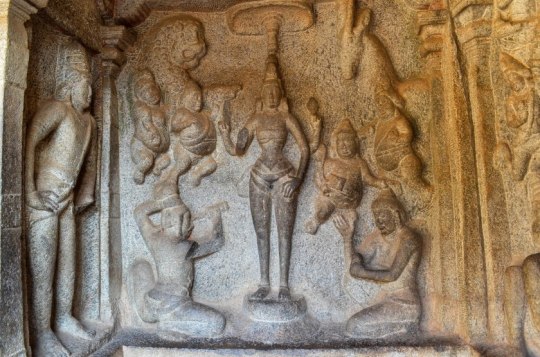
Durga panel: here the devi is shown in katyavalambita and abhaya mudra. The chattri
above her denotes her complete sovereignty. On two sides of the devi are a lion, an antelope, ganas, and two male devotees of the Kabalika sect with the
one on her right cutting and offering his head (a sacrificial representation).

Trivikrama panel: Vishnu is seen holding a bow, shield, and sword, along with his sankha, chakra and gada. Among the figures present around him are the Sun and Moon, while Bali and his demons are shown at his feet. Brahma and Shiva sitting on lotuses on two sides are also shown as witnessing the event, while on top part we find Jambavan beating a drum in happiness celebrating the defeat of Bali. The figure on left of Trivikrama seen bent and flying in mid-air is likely that of Trisanku, whose space is half way between the earth and heaven. Since the foot of Vishnu reaches above Trisankhu, it denotes his foot has reached heaven.

Rayala gopuram: a little ahead of the Varaha mandapa is
an unfinished gopuram of the Vijayanagara period, with their typical jamb decorations.
This is the second unfinished gopuram of the Vijayanagara dynasty in Mahabalipuram, the first one being seen in front of the Sthalasayana Perumal temple.

Ornamentation seen on the unfinished Vijaynagara rayala, Ganga on makara

Krishna’s butter ball
Besides the ones mentioned here, and in my previous article, there are many more rock cut caves that are a must visit in Mahabalipuram, which include the Mahisasurmardini caves, AdiVaraha cave, Tiger cave, among others. The main Mahabalipuram hill holds many more caves and unfinished rathas, which are definitely worth seeing. There is also a temple near Mahabalipuram, which came up during the 2004 tsunami and is now an ASI site. Mahabalipuram needs around 2-3 days if one wants to take a detailed look at all the beautiful heritage structures that this ancient city holds.
What to explore in Mahabalipuram (Part II) – The Pancha Rathas, Krishna Mandapa, and other Rock Cut caves The origin of monument building in Mahabalipuram is attributed to the mighty Pallava dynasty that ruled south India from around 3rd century CE with their capital at Kanchipuram, after the decline of their overlords, the Satavahanas.
#ancient#art#buddhism#chennai#culture#hinduism#history#india#mahabalipuram#mamallapuram#pallavas#pallavascript#pancharathas#photography#rathas#religion#rock cut caves#rock relief#southeastasia#tamil nadu#tourism#travel#unescoworldheritagesites#worship
0 notes
Photo

Tirumala Balajai Brahmotsavam 2018 Dates, Vahanam details
Date Day Morning Evening
13 Sep Thu Dwajarohanam Pedda Sesha Vahanam
14 Sep Fri Chinna Sesha Vahanam Hamsa Vahanam
15 Sep Sat Simha Vahanam Muthyapu Pandiri Vahanam
16 Sep Sun Kalpavruksha Vahanam Sarva Bhoopala Vahanam
17 Sep Mon Mohini Avataram Garuda Vahanam
18 Sep Tue Hanumantha Vahanam Gaja Vahanam
19 Sep Wed Surya Prabha Vahanam Chandra Prabha Vahanam
20 Sep Thu Rathotsavam Aswa Vahanam
21 Sep Fri Chakra Snanam Dwaja Avarohanam
Book your Seegra Darashan Ticket and Hotel at Tirupati today and Get 30% OFF at Tripnetra
https://tripnetra.com/
Plan your Stay and Travel with us @ TRIPNETRA, Get 30% OFF and amazing deals on Luxury and Budget Hotels Online booking.We offer Special Packages on Confirmed Tirupati Tirumala Balaji Seegra Darshan packages, Customized Tour and Travel Packages
Assured quality Services and Secure Booking.
Dedicated support, 24*7 Customer service at 8500898000
#Tirumala Salakatla Brahmotsavam 2018 schedule#Srivari Gaja vahana Seva Timings#Tirumala Garuda Vahana Tickets#TTD Vahana seva Details
0 notes
Text
Tirupati Tirumala Salakatla Brahmotsavam 2018
Tirumala Salakatla Brahmotsavam 2018 Dates, Vahanam details
Date Day Morning Evening
13 Sep Thu Dwajarohanam Pedda Sesha Vahanam
14 Sep Fri Chinna Sesha Vahanam Hamsa Vahanam
15 Sep Sat Simha Vahanam Muthyapu Pandiri Vahanam
16 Sep Sun Kalpavruksha Vahanam Sarva Bhoopala Vahanam
17 Sep Mon Mohini Avataram Garuda Vahanam
18 Sep Tue Hanumantha Vahanam Gaja Vahanam
19 Sep Wed Surya Prabha Vahanam Chandra Prabha Vahanam
20 Sep Thu Rathotsavam Aswa Vahanam
21 Sep Fri Chakra Snanam Dwaja Avarohanam
#Tirumala Salakatla Brahmotsavam 2018 dates#Tirumala Salakatla Brahmotsavam 2018 timings#Tirumala Salakatla Brahmotsavam vahanam images#Tirumala Salakatla Brahmotsavam starting date
0 notes